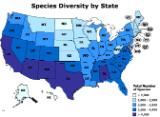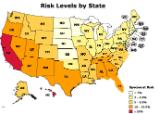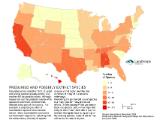Geography of Diversity and Risk
By Bruce A. Stein
The way in which life evolved and inhabited the nation’s lands and waters has been influenced primarily by patterns in climate, landform, and geological history. The biological wealth of a region expresses the interaction between these physical features and the distinctive evolutionary histories of particular organisms. Adding to this complexity is the intersection between natural history and human history. Indeed, the breadth and intensity of this interaction tends to define a geography of risk for natural ecosystems and wild species. Identifying the most significant open spaces for protection of plant and animal species requires an understanding of this geography of diversity and risk.
State of the States
Nature is not limited by lines on a map, and state boundaries are merely artificial constructs superimposed on an ecologically complex landscape. From both a biological and conservation perspective, characterizing the landscape based on state boundaries has serious shortcomings, including the enormous disparity in size between states like Rhode Island and Alaska. Nonetheless, these geographic units are embedded in our culture and consciousness in a way that more ecologically sensible units -- whether ecoregions, watersheds, or biomes -- are not. And because of the way in which scientific data historically has been gathered, state-based assessments allow us to consider patterns for the broadest array of species, both rare and common.
Assessing biological condition and ecological health is a complex endeavor. Ideally one would consider both species and ecosystems, and the degree to which their composition, structure, and function compares to original conditions. Unfortunately, most of the data that would allow this idealized assessment on a state-by state basis does not exist. Instead, we focus here on four characteristics that provide more limited but still useful measures of the biological condition of the states, and for which we have consistent and comparable information: diversity, risk, endemism, and extinctions. Several characteristics provide useful measures of the biological condition of a state, including diversity, risk, endemism, and extinctions.
Diversity
The number of different native species—or species “richness”—is the most prevalent measure of diversity and provides a general measure of biological wealth. As the map at right illustrates, states with the greatest diversity extend in a band along the southern border, with Alabama having the highest diversity east of the Mississippi. California leads the nation in the total number of species. The variability of the state’s landforms, climate, and soil types has fostered development of an array of specialized habitat types and been the principal driver in the evolution of a highly distinctive flora and fauna. Alabama stands out for having the greatest species diversity east of the Mississippi. The state is home to an exceptionally rich freshwater fauna, thanks to an ancient and complex geological terrain and more than 235,000 miles of waterways spanning three major river basins. The state was also spared from the direct effects of the Pleistocene glaciers, enabling its flora and fauna to continue diversifying even during this unsettled geological period.
Risk
The percentage of a state’s plants and animals that are at risk of extinction due to rarity or other factors provides a measure of the scale of the conservation challenge. This measure includes species with a conservation status of extinct, imperiled, or vulnerable (GX through G3). Hawaii and California lead the nation in the proportion of their flora and fauna at risk. Hawaii in particular has an extraordinarily threatened biota with more than 60% of its native species at risk. Because Hawaii’s native species developed in isolation, however, they have been particularly sensitive to the many changes brought about by human colonization of the islands, first by Polynesians and later by westerners.
Endemism
The number of species endemic—or unique—to a particular state provides a measure of its biological distinctiveness. Because these endemic species are found nowhere else in the world, their fate rests exclusively with conservation efforts carried out in that state. California has the largest number of endemic species, while Hawaii has by far the highest proportion of endemics.
Extinctions
The number of species that are presumed or possibly extinct (GX and GH) measures the amount of diversity already lost. This measure includes only those species that are globally extinct—that is, have disappeared from their entire former range—and does not include species that have disappeared from one state but still exist elsewhere. Again, three states—Hawaii, Alabama, and California—stand out for the number of species already lost, or missing in action and possibly extinct.
Go Straight to Your State
Learn about conservation and open space in your state.





